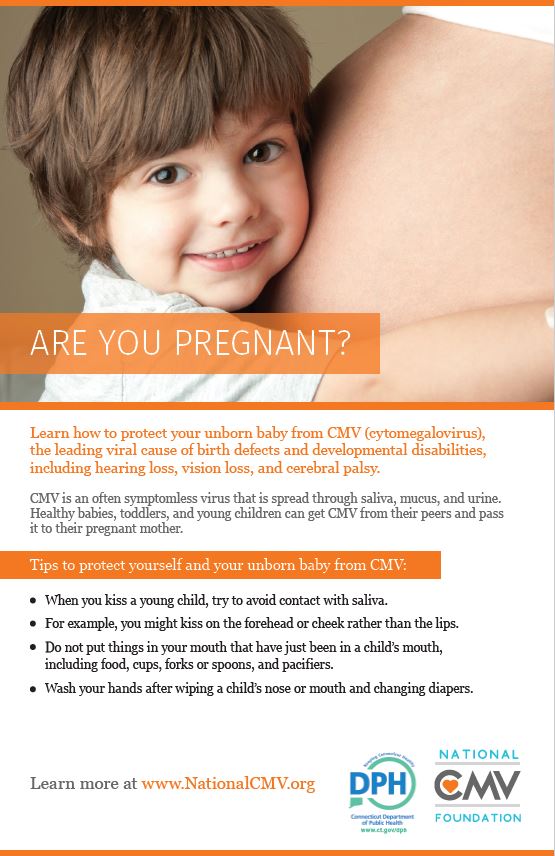EHDI Home | Parent FAQs |For Providers | Resources & Forms |
Risk Factors & Genetics | Congenital CMV |Contact EHDI
Early Hearing Detection and Intervention Program
What is cytomegalovirus (CMV) and congenital cytomegalovirus (cCMV)?
Cytomegalovirus (pronounced: sy-toe-MEG-a-low-vy-rus), or CMV, is a common virus that infects people of all ages and is generally passed from infected people to others through direct contact with body fluids, such as urine, saliva (spit), and breast milk. The majority of people who are infected with CMV have no signs or symptoms of the virus and there are no harmful effects.
When CMV occurs during a woman’s pregnancy and the unborn baby becomes infected, it is called congenital CMV (cCMV). According to the Centers for Disease Control and Prevention (CDC), one in five babies born with cCMV will have long term health problems. In fact, cCMV is the leading non-genetic cause of hearing loss in children at birth.
On January 1, 2016, C.G.S. Sec. 19a-55 was amended to require every Connecticut-born infant who fails their newborn hearing screening also be screened for congenital Cytomegalovirus (CMV), as soon after birth as is medically appropriate.
For Parents:
Is cCMV harmful to my baby?
Congenital CMV can potentially damage the brain, eyes, and/or inner ears of the unborn infant. Health problems or disabilities due to cCMV infection may be present at birth, may appear during childhood, or may never appear at all.
According to the CDC, some babies with cCMV infections have the following signs at birth:
• Rash
• Jaundice (yellowing of the skin or whites of the eyes)
• Microcephaly (small head)
• Intrauterine growth restriction (low weight)
• Hepatosplenomegaly (enlarged liver and spleen)
• Seizures
• Retinitis (damaged eye retina)
Permanent health problems or disabilities associated with cCMV infection may include:
• Hearing Loss
• Developmental and motor delay
• Vision loss
• Small Head Size (Microcephaly)
• Seizures
• Death (In rare cases)
Please note that if a baby contracts CMV after being born, the chances of having any of the severe effects listed above are greatly reduced, but you should speak with your pediatrician or an infectious disease doctor if you have concerns.
What is the best way to protect an unborn baby from CMV?
For pregnant women, one of the two most common exposures to CMV is through contact with the urine and saliva of young children with CMV infection. Although less common, another source of CMV exposure is sexual contact with a CMV infected partner. If you are pregnant, or planning a pregnancy, the best way to protect your baby from CMV is to avoid exposure to bodily fluids that might contain CMV. Pregnant women who work closely with children or who have other children, should discuss their risk for CMV infection with their medical provider.
Pregnant women may want to take the following steps to reduce their risk of exposure to CMV and so reduce the risk of CMV infection of their unborn infant:
-
Wash your hands often with soap and water for 15-20 seconds, especially after:
-
Changing diapers
-
Feeding a young child
-
Wiping a young child’s nose or drool
-
Handling children’s toys
-
-
Do not share food, drinks, or eating utensils used by young children.
-
Do not put a child’s pacifier in your mouth.
-
Do not share a toothbrush with a young child.
-
Avoid contact with saliva when kissing a child.
-
Clean toys, countertops, and other surfaces that come into contact with children’s urine or saliva

How is cCMV diagnosed?
A painless saliva or urine test is used to diagnose cCMV. The saliva or urine samples must be taken before 21 days of age to determine if it is cCMV or acquired CMV (the baby is infected with CMV after being born).
What should you do if your baby is diagnosed with cCMV?
Ask your doctor to see the appropriate specialists, including an infectious disease doctor, an audiologist, and an optometrist/ophthalmologist (eye doctor). Also, since cCMV can cause hearing and vision loss overtime, your child should be monitored on a regular basis.
According to the CDC, there may be some treatment options for babies who show signs of cCMV infection at birth. Visit CDC’s website at https://www.cdc.gov/cmv/congenital-infection.html for more information. Be sure to discuss any questions or concerns you have regarding diagnosis and treatment of cCMV with your pediatrician.
For Childcare Providers and Pediatrics Professionals:
Due to frequent contact with young children, childcare providers and other pediatric professionals, may be at greater risk for CMV. According to the National CMV Foundation, “Contact with infected bodily fluids, including saliva or urine of young children, is a major cause of CMV infection among pregnant women – especially mothers, daycare workers, preschool teachers, therapists, and nurses. Studies in childcare settings suggest that as many as 75% of toddler-aged children have CMV in their urine or saliva, and viable CMV can persist on hands for at least 15 minutes.” Following standard hygiene practices mentioned above may help prevent the spread of CMV.
Resources for Health Care Providers:
Centers for Disease Control and Prevention (CDC) CMV Fact Sheet for Healthcare Providers and visit their website at https://www.cdc.gov/cmv/clinical/congenital-cmv.html.
Department of Public Health (DPH) About CMV For Obstetric Health Care Providers and About CMV Testing for Obstetric Health Care Providers.
Department of Public Health (DPH) and American Academy of Pediatrics (AAP) About CMV for Pediatric Care Providers.
Click here to view the National Center for Hearing Assessment and Management (NCHAM) pre-recorded Congenital CMV 101: From Prevention to Treatment webinar or click here for a PDF of the webinar.
Websites:
For more information on CMV and cCMV Infections, visit the Centers for Disease Control and Prevention at https://www.cdc.gov/cmv or the National CMV Foundation at https://www.nationalcmv.org.

